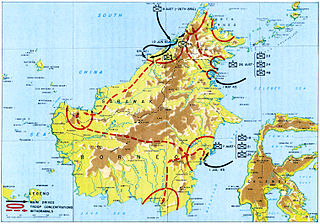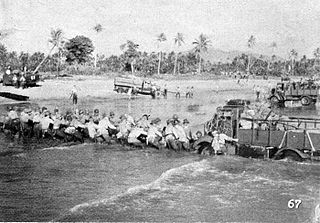
The Southern Expeditionary Army was an army group of the Imperial Japanese Army during World War II. It was responsible for all military operations in South East Asian and South West Pacific campaigns of World War II. Its military symbol was NA.

The Asiatic-Pacific Theater, was the theater of operations of U.S. forces during World War II in the Pacific War during 1941–45. From mid-1942 until the end of the war in 1945, there were two U.S. operational commands in the Pacific. The Pacific Ocean Areas (POA), divided into the Central Pacific Area, the North Pacific Area and the South Pacific Area, were commanded by Admiral Chester W. Nimitz, Commander-in-Chief Pacific Ocean Areas. The South West Pacific Area (SWPA) was commanded by General Douglas MacArthur, Supreme Allied Commander South West Pacific Area. During 1945, the United States added the United States Strategic Air Forces in the Pacific, commanded by General Carl A. Spaatz.

The Battle of the Java Sea was a decisive naval battle of the Pacific campaign of World War II.

Balikpapan is a seaport city on the east coast of the island of Borneo, in the Indonesian province of East Kalimantan. Two harbors, Semayang and Kariangau, and Sultan Aji Muhammad Sulaiman Airport are the main transportation ports to the city. Balikpapan is the industrial, transportational, commercial and financial center of Kalimantan. The city has a population of 736,806; making it the second most populous city in East Kalimantan, after Samarinda.

The Battle of Makassar Strait, also known as the Action of Madura Strait, the Action North of Lombok Strait and the Battle of the Flores Sea, was a naval battle of the Pacific theater of World War II. An American-British-Dutch-Australian (ABDA) fleet—under Schout by-nacht Karel Doorman—was on its way to intercept a Japanese invasion convoy reported as bound for Surabaya, when it was attacked by 36 Mitsubishi G4M1 "Betty" and 24 Mitsubishi G3M2 "Nell" medium bombers, which forced the fleet to retreat.

USS Pope (DD-225) was a Clemson-class destroyer in the United States Navy that served during World War II. She was the first ship named for John Pope.

USS John D. Ford (DD-228/AG-119) was a Clemson-class destroyer in the United States Navy during World War II. She was named for Rear Admiral John Donaldson Ford.

USS Childs (DD-241/AVP-14/AVD-1) was a Clemson-class destroyer in the United States Navy during World War II. She was named for Earle W. F. Childs.

USS Burns (DD-588), a Fletcher-class destroyer, was the second ship of the United States Navy to be named for Captain Hugh Otway Burns (1775–1850), a privateer in the War of 1812.

The Borneo campaign of 1945 was the last major Allied campaign in the South West Pacific Area during World War II to liberate the-Japanese held British Borneo and Dutch Borneo. In a series of amphibious assaults between 1 May and 21 July, the Australian I Corps, under Lieutenant General Leslie Morshead, attacked Imperial Japanese forces occupying the island. Allied naval and air forces, centred on the U.S. 7th Fleet under Admiral Thomas Kinkaid, the Australian First Tactical Air Force and the U.S. Thirteenth Air Force also played important roles in the campaign. They were resisted by Imperial Japanese Navy and Army forces in southern and eastern Borneo, under Vice-Admiral Michiaki Kamada, and in the north west by the Thirty-Seventh Army, led by Lieutenant-General Masao Baba.

Naka (那珂) was a Sendai-class light cruiser in the Imperial Japanese Navy (IJN), named after the Naka River in the Tochigi and Ibaraki prefectures of eastern Japan. Naka was the third vessel completed in the Sendai class of light cruisers, and like other vessels of her class, she was intended for use as the flagship of a destroyer flotilla.

The Battle of Tarakan took place on January 11–12, 1942, beginning a day after the Empire of Japan declared war on the Kingdom of the Netherlands. Although Tarakan was only a small marshy island off northeastern Borneo in the Netherlands East Indies, the island's 700 oil wells, oil refinery, and airfield made it a crucial objective for Japan in the Pacific War.

No. 18 Squadron was a joint Dutch and Australian bomber squadron of World War II. Formed in April 1942, the squadron was staffed by a mixture of Dutch and Australian personnel and placed under Royal Australian Air Force operational command. Initially it undertook anti-submarine patrols on the east coast of Australia, before moving to northern Australia and taking part in operations against the Japanese in the islands of the Netherlands East Indies (NEI). At the conclusion of hostilities, the squadron came under Dutch control and Australian personnel were transferred out. The squadron then undertook operations during the Indonesian National Revolution, before eventually being disbanded in July 1950 after being transferred to Indonesia.

The South West Pacific theatre, during World War II, was a major theatre of the war between the Allies and the Axis. It included the Philippines, the Dutch East Indies, Borneo, Australia and its mandate Territory of New Guinea and the western part of the Solomon Islands. This area was defined by the Allied powers' South West Pacific Area (SWPA) command.

The Dutch East Indies Campaign of 1941–1942 was the conquest of the Dutch East Indies by forces from the Empire of Japan in the early days of the Pacific Campaign of World War II. Forces from the Allies attempted unsuccessfully to defend the islands. The East Indies were targeted by the Japanese for their rich oil resources which would become a vital asset during the war. The campaign and subsequent three and a half year Japanese occupation was also a major factor in the end of Dutch colonial rule in the region.

Tarakan is the largest city of the Indonesian province of North Kalimantan. The island of Tarakan is located in northern Borneo, just across the border from Sabah, Malaysia. Once a major oil-producing region during the colonial period, Tarakan had great strategic importance during the Pacific War and was among the first Japanese targets early in the war. It is the sole city within the newly established Indonesian province of North Kalimantan.

No. 77 Wing was a Royal Australian Air Force (RAAF) wing of World War II. It formed part of No. 10 Operational Group at its establishment in November 1943, when it comprised three squadrons equipped with Vultee Vengeance dive bombers. No. 77 Wing commenced operations in early 1944, flying out of Nadzab, Papua New Guinea. Soon afterwards, however, the Vengeance units were withdrawn from combat and replaced with squadrons flying Douglas Bostons, Bristol Beaufighters and Bristol Beauforts. The wing saw action in the assaults on Noemfoor, Tarakan, and North Borneo, by which time it was an all-Beaufighter formation made up of Nos. 22, 30 and 31 Squadrons. It was to have taken part in the Battle of Balikpapan in June 1945, but unsuitable landing grounds meant that the Beaufighter units were withdrawn to Morotai, sitting out the remainder of the war before returning to Australia, where they disbanded, along with the wing headquarters, in 1946.

Major General Edward James Milford was an Australian Army officer who fought in the First and the Second World Wars.


















